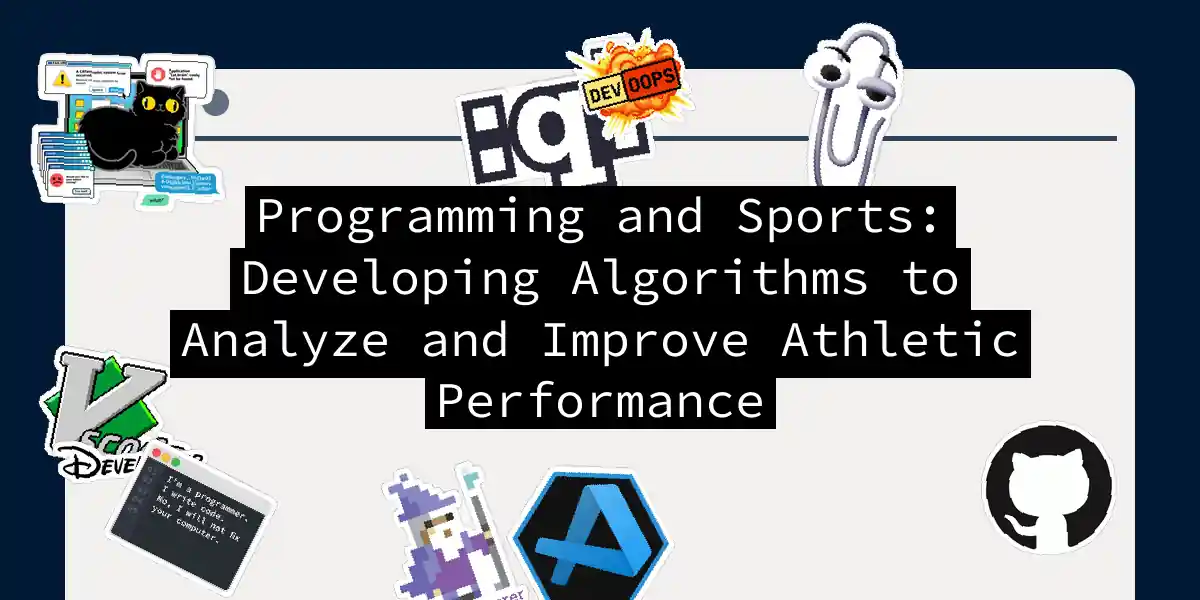The Intersection of Programming and Sports
In the world of sports, performance is everything. Athletes and teams are constantly seeking ways to improve their skills, optimize their strategies, and gain a competitive edge. One often overlooked but highly effective tool in this pursuit is programming. By leveraging algorithms and data analysis, programmers can help athletes and teams enhance their performance, predict outcomes, and make informed decisions.
The Role of Algorithms in Sports
Algorithms are the backbone of any analytical endeavor in sports. They enable the processing of vast amounts of data, from player statistics to game dynamics, and provide insights that can be crucial for improvement.
Example: Analyzing Player Performance
Imagine you are a coach of a basketball team, and you want to analyze the performance of your players. Here’s how you might approach this using programming:
You can use Python with libraries like Pandas and Scikit-learn to collect, preprocess, and analyze the data.
import pandas as pd
from sklearn.model_selection import train_test_split
from sklearn.linear_model import LinearRegression
# Load data
data = pd.read_csv('player_stats.csv')
# Preprocess data
X = data[['Games Played', 'Points Scored', 'Rebounds']]
y = data['Efficiency Rating']
# Split data into training and testing sets
X_train, X_test, y_train, y_test = train_test_split(X, y, test_size=0.2, random_state=42)
# Apply linear regression model
model = LinearRegression()
model.fit(X_train, y_train)
# Predict efficiency rating
y_pred = model.predict(X_test)
# Evaluate the model
print("Model Score:", model.score(X_test, y_test))
This example demonstrates how to use a simple linear regression model to predict a player’s efficiency rating based on their performance metrics.
Predictive Analytics in Sports
Predictive analytics is another powerful tool in the arsenal of sports analytics. By using historical data and advanced algorithms, teams can predict game outcomes, player injuries, and even fan behavior.
Example: Predicting Game Outcomes
To predict the outcome of a game, you can use a more complex model like a decision tree or a neural network. Here’s an example using a decision tree:
Using Python with Scikit-learn, you can implement this as follows:
from sklearn.tree import DecisionTreeClassifier
from sklearn.model_selection import train_test_split
from sklearn.metrics import accuracy_score
# Load data
data = pd.read_csv('game_results.csv')
# Preprocess data
X = data[['Team1_Win_Pct', 'Team2_Win_Pct', 'Team1_Avg_Score', 'Team2_Avg_Score']]
y = data['Winner']
# Split data into training and testing sets
X_train, X_test, y_train, y_test = train_test_split(X, y, test_size=0.2, random_state=42)
# Train decision tree model
model = DecisionTreeClassifier()
model.fit(X_train, y_train)
# Predict game outcome
y_pred = model.predict(X_test)
# Evaluate the model
print("Model Accuracy:", accuracy_score(y_test, y_pred))
This code snippet shows how to train a decision tree classifier to predict the winner of a game based on historical team statistics.
Real-Time Data Analysis
Real-time data analysis is crucial in sports, especially during live games. It allows coaches and analysts to make immediate adjustments based on current performance.
Example: Real-Time Player Tracking
In sports like soccer or basketball, real-time player tracking can provide valuable insights into player positioning, movement patterns, and fatigue levels. Here’s a simplified example of how you might set up real-time tracking using Python and the OpenCV library:
Using OpenCV, you can detect and track players in real-time:
import cv2
import numpy as np
# Capture video feed
cap = cv2.VideoCapture('game_footage.mp4')
while True:
ret, frame = cap.read()
if not ret:
break
# Convert frame to HSV and apply thresholding
hsv = cv2.cvtColor(frame, cv2.COLOR_BGR2HSV)
lower = np.array([0, 0, 0])
upper = np.array([255, 255, 255])
mask = cv2.inRange(hsv, lower, upper)
# Detect players using contours
contours, _ = cv2.findContours(mask, cv2.RETR_EXTERNAL, cv2.CHAIN_APPROX_SIMPLE)
for contour in contours:
area = cv2.contourArea(contour)
if area > 100:
x, y, w, h = cv2.boundingRect(contour)
cv2.rectangle(frame, (x, y), (x+w, y+h), (0, 255, 0), 2)
# Display the resulting frame
cv2.imshow('Frame', frame)
if cv2.waitKey(1) & 0xFF == ord('q'):
break
cap.release()
cv2.destroyAllWindows()
This code snippet demonstrates how to capture a video feed, detect players, and track their movement in real-time.
The Future of Sports Analytics
As technology advances, the role of programming in sports analytics will only continue to grow. Here are some trends to watch:
- Machine Learning and AI: More sophisticated machine learning models will be used to predict player injuries, optimize team strategies, and analyze fan behavior.
- IoT and Wearable Devices: The use of IoT devices and wearables will provide more detailed and real-time data on player performance and health.
- Cloud Computing: Cloud platforms will enable faster data processing and analysis, allowing for quicker decision-making.
Conclusion
Programming is no longer just a tool for software development; it has become an integral part of the sports world. By developing algorithms to analyze and improve athletic performance, programmers can help athletes and teams gain a competitive edge. Whether it’s predicting game outcomes, tracking player movement in real-time, or analyzing historical data, the intersection of programming and sports is a fertile ground for innovation and improvement.
So, the next time you watch a game, remember the programmers working behind the scenes, crunching numbers and writing code to help their teams win. It’s a game of strategy, skill, and code – and it’s only getting more exciting.
